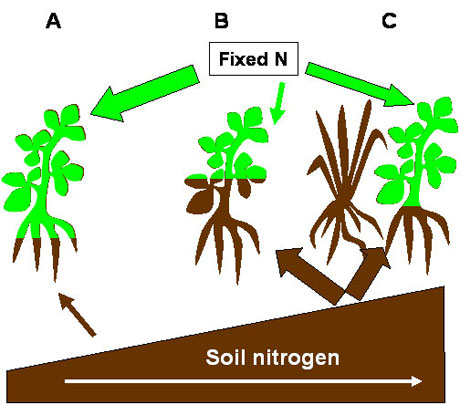Legume nitrogen fixation learning module
Managing legume N fixation by planting species mixtures
One strategy that seems to work well in organic production systems is to use legumes in cover crop mixes with other non-N-fixing plant species such as grasses. This intercropping approach can enhance the capacity of cover crops to regulate soil nutrient balances. When legumes are grown in intercrops with grasses, the amount of N fixed depends on soil N availability, the proportion of legumes in the mixture, and the legume N fixation rate.
In soils that are N-limited, the legumes will grow and produce more biomass than the grasses. Under low N conditions, legumes out-compete grasses because of their N-fixing ability. In this situation, N fixed may be very similar for both the intercrop and monoculture situation.
If soil N is sufficient to support grasses or other non-N fixing plants, they will usually out-compete legumes for available soil N and this will stimulate the legume to fix a greater proportion of N compared to when it is grown in a monoculture. (Figure 1).
In soils where N is relatively abundant, the total N fixed in a mixed stand will tend to be lower compared to a pure stand because the total biomass of the legume will generally be lower due to competition with the grass.
The outcome from legume-grass mixes grown in the same soil can vary, depending on how the two species interact. For example, in Table 1 the total N fixed by cowpea in an intercrop can increase or decrease compared to the cowpea monoculture depending on the species of grass used. Also notice in Figure 1 that the forage soybean fixed more than twice the amount of N as the cowpea when grown by itself, but it was not able to compete with the grasses and fixed much less N than the cowpea when grown in an intercrop.

Figure 1. Interaction of soil fertility, legume intercrops and nitrogen fixation. As soil nitrogen availability increases, legume nitrogen fixation decreases. Plant A is dependent on nitrogen fixation to a greater degree than plant B which is growing in soil with higher nitrogen fertility. Adding a non-fixing plant, such as a grass, as an intercrop can increase nitrogen fixation under high soil nitrogen conditions because the grass out-competes the legume for available soil nitrogen as illustrated in C. However, total legume biomass will be lower for C because it is grown in an intercrop. The total amount of nitrogen fixed may be similar between B and C, but C retains and recycles more total nitrogen than B.
| Table 1. Results from our field studies of N fixation from a variety of legumes grown in monoculture or mixture with grasses. Notice that all of the legumes have higher rates of N fixation when grown in mixture. |
| Cover crop species |
% N from fixation |
Total N fixed (lbs/ac) |
| Clover |
77 |
45* |
| Clover with winter grain |
86 |
47* |
| Clover + orchardgrass |
86 |
29* |
| Peas |
70 |
25 |
| Peas + oats |
85 |
17 |
| Grain soybean |
58 |
115** |
| Forage soybean |
67 |
88 |
| Forage soybean + Japanese millet |
82 |
28 |
| Forage soybean + Sorghum-Sudan |
90 |
35 |
| Cowpea |
39 |
37 |
| Cowpea + Japanese millet |
72 |
59 |
| Cowpea + Sorghum-Sudan |
56 |
26 |
*Total N fixed is only from the fall sampling and does not include N fixed in the spring for the red clover.
**Approximately 103 lbs/ac of grain soybean N is removed from the field during harvest, leaving a net gain of 12 lbs/ac. |
Pulling it all together.
After reading about the effects of soil fertiliy, species selection, and intercropping on N fixation, how would you manage legume N fixation for:
- a field in transition to organic management with low soil organic matter?
- a field that has been managed organically for over 10 years and has higher soil organic matter?
See our thoughts on these questions: Managing N fixation at different stages of soil organic matter development.
© Copyright, Department of Horticulture, Cornell University.
Logo graphics by Rachel Kennedy.
Design by Craig Cramer.
Mention of trade names and commercial products is for educational purposes; no discrimination is intended and no endorsement by Cornell Cooperative Extension or Cornell University is implied. Pesticide recommendations are for informational purposes only and manufacturers' recommendations change. Read the manufacturers' instructions carefully before use. Cornell Cooperative Extension and Cornell University assumes no responsibility for the use of any pesticide or chemicals. Some of the links provided are not maintained by Cornell Cooperative Extension and Cornell University. Cornell Cooperative Extension and Cornell University are not responsible for information on these websites. They are included for information purposes only and no endorsement by Cornell Cooperative Extension or Cornell University is implied. Cornell Cooperative Extension provides equal program and employment opportunities.